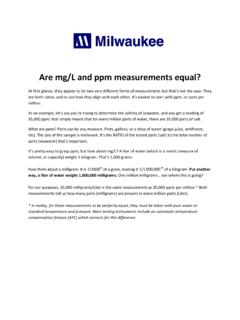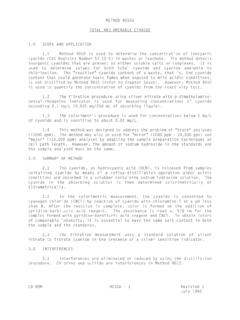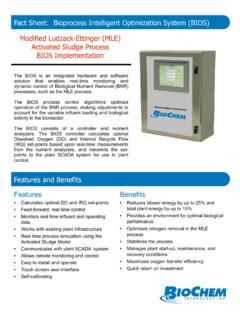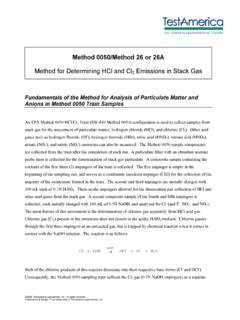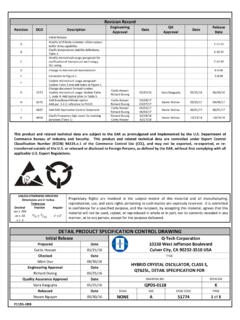Transcription of SODIUM HYALURONATE - SIMPEX - WELCOME
1 SODIUM glycerophosphate, hydratedEUROPEAN PHARMACOPOEIA :1995 SODIUM GLYCEROPHOSPHATE,HYDRATEDN atrii glycerophosphas hydricusC3H7Na2O6P, (anhydrous substance)DEFINITIONM ixture of variable proportions of SODIUM (2RS)-2,3-dihydroxypropyl phosphate and sodium2-hydroxy-1-(hydroxymethyl)ethyl phosphate. The degreeof hydration is 4 to : per cent to per cent (anhydroussubstance).CHARACTERSA ppearance: white, crystalline powder or : freely soluble in water, practically insoluble inacetone and in Solution S (see Tests) gives reaction (a) of SODIUM ( ).B. To g add 5 ml ofdilute nitric acid boil for 1 min. Cool. The solution gives reaction (b)of phosphates ( ).C. In a test-tube fitted with a glass tube, mix g with 5 gofpotassium hydrogen sulphate the white vapour into 5 ml ofdecolorised fuchsinsolution R.
2 A violet-red colour develops which becomesviolet upon heating for 30 min on a S. Dissolve g incarbon dioxide-free water Rprepared fromdistilled water Rand dilute to 100 ml withthe same of solution. Solution S is not more opalescentthan reference suspension II ( ) and not more intenselycoloured than reference solution Y6( , Method II). solution Mhydrochloric acidis required to change the colour of theindicator, (n2).Glycerol and alcohol-soluble g with 25 ml ofalcohol Rfor 10 min. the filtrate on a water-bath and dry the residue at70 C for 1 h. The residue weighs not more than 10 ( ): maximum 200 ml of solution S to 15 ml withwater ( ): maximum per 1 ml of solution S to 10 ml withwater this solution to 100 ml withwater ( ): maximum 500 3 ml of solution S to 15 ml withwater ( ): maximum 20 5 ml of solution S to 10 ml withwater metals( ): maximum 20 10 ml of solution S to 20 ml withwater solution complies with limit test A.
3 Prepare the standardusing 10 ml oflead standard solution (1 ppm Pb) ( ): per cent to per cent, determinedon g in 30 ml ofwater Msulphuric acid, determining the end-point potentiometrically( ), (n1).Calculate the percentage content of SODIUM glycerophosphate(anhydrous substance) from the expression:a=percentage content of water,n1=volume M sulphuric acidused in theassay, in millilitres,n2=volume M hydrochloric acidused in thetest for alkalinity, in millilitres,m=mass of the substance to be examined, in :1472correctedSODIUM HYALURONATEN atrii hyaluronas(C14H20 NNaO11)nDEFINITIONS odium HYALURONATE is the SODIUM salt of hyaluronic acid,a glycosaminoglycan consisting ofD-glucuronic acid andN-acetyl-D-glucosamine disaccharide units.
4 It contains notless than per cent and not more than the equivalentof per cent of SODIUM HYALURONATE , calculated withreference to the dried substance. It has an intrinsic viscosityof not less than 90 per cent and not more than 120 per centof the value stated on the HYALURONATE is extracted from cocks combs orobtained by fermentation fromStreptococci, LancefieldGroups A and C. It is produced by methods of manufacturedesigned to minimise or eliminate infectious agents. Whenproduced by fermentation of gram-positive bacteria, theprocess must be shown to reduce or eliminate pyrogenic orinflammatory components of the cell white or almost white, very hygroscopic powder or afibrous aggregate, sparingly soluble to soluble in water,practically insoluble in acetone and in the information section on general monographs (cover pages)EUROPEAN PHARMACOPOEIA hyaluronateIDENTIFICATIONA.
5 Examine by infrared absorption spectrophotometry( ), comparing with thePh. Eur. reference spectrumof SODIUM It gives reaction (a) of SODIUM ( ).TESTSS olution S. Weigh a quantity of the substance to be examinedequivalent to g of the dried substance and add mlof a 9 g/l solution ofsodium chloride until dissolved (about 12 h).Appearance of solution. Solution S is clear ( ). Theabsorbance of solution S measured at 600 nm ( )isnot greater than ( ). Dissolve the substance to be examined incarbon dioxide-free water Rto obtain a solution containinga quantity equivalent to 5 mg of the dried substance permillilitre. The pH of the solution is to HYALURONATE is very hygroscopicand must be protected from moisture during solution ( M SODIUM chloride in Mphosphate buffer solution pH ).
6 Dissolve g ofsodium dihydrogen phosphate Rand g ofsodiumchloride Rinwater (solution A). Dissolve g ofdisodium hydrogenphosphate Rand g ofsodium chloride Rinwater Rand dilute to ml with the same solvent (solution B).Mix solutions A and B until a pH of is reached. Filterthrough a sintered-glass filter (4).Test solution (a) (concentration c1of SODIUM HYALURONATE ).Weigh g (m0p)(NOTE: this value is only indicativeand should be adjusted after an initial measurement of theviscosity of test solution (a))of the substance to be examinedand dilute with g (m0s) of buffer solution at 4 C. Mixthe solution by shaking at 4 C during 24 h. Weigh g(m1p) (m1s)ofbuffersolution at 25 C. Mix this solution by shaking for 20 the solution through a sintered-glass filter (100), anddiscard the first 10 solution (b) (concentration c2of SODIUM HYALURONATE ).
7 Weigh g (m2p) of test solution (a) and dilute with g(m2s) of buffer solution at 25 C. Mix this solution by shakingfor 20 min. Filter the solution through a sintered-glassfilter (100) and discard the first 10 solution (c) (concentration c3of SODIUM HYALURONATE ).Weigh g (m3pof test solution (a) and dilute with g(m3s) of buffer solution at 25 C. Mix this solution by shakingfor 20 min. Filter the solution through a sintered-glassfilter (100) and discard the first 10 solution (d) (concentration c4of SODIUM HYALURONATE ).Weigh g (m4pof test solution (a) and dilute with g(m4s) of buffer solution at 25 C. Mix this solution by shakingfor 20 min. Filter the solution through a sintered-glassfilter (100) and discard the first 10 (t0)andthe flow times for the four test solutions (t1,t2,t3andt4), C( ).))
8 Use an appropriate suspendedlevel viscometer (specifications: viscometer constant mm2/s2, kinematic viscosity range 1 to 5 mm2/s2,internal diameter of mm, volume of ml, internal diameter of mm to mm) with afunnel-shaped lower capillary end. Use the same viscometerfor all measurements; measure all outflow times in per cent from the mean and if the flow timet1isnot less than and not more than case, adjust the value ofm0pand repeat the of the relative viscositiesSince the densities of the SODIUM HYALURONATE solutions andofthesolventarealmostequal,therelativ eviscosities ri(being r1, r2, r3and r4)canbecalculatedfromtheratioof the flow times for the respective solutionsti(beingt1,t2,t3andt4) to the flow time of the solventt0,buttakinginto account the kinetic energy correction factor for thecapillary (B=30800s3), as shown below.
9 Calculation of the concentrationsCalculation of the concentration c1(expressed in kg/m3)ofsodium HYALURONATE in test solution (a)x=percentage content of SODIUM HYALURONATE asdetermined under Assay,h=loss on drying as a percentage, 25=1005 kg/m3(densityofthetestsolutionat25 C).Calculation of the other concentrationsCalculation of the intrinsic viscosityThe intrinsic viscosity [ ] is calculated by linear least-squaresregression analysis using the Martin equation:The decimal antilogarithm of the intercept is the intrinsicviscosity expressed in m3 the product isextracted from cocks combs, it complies with the followingrequirement. Appropriate safety precautions are to be takenwhen handling perchloric acid at elevated a quantity of the substance to beexamined equivalent to mg of the driedsubstanceintoa test-tube 150 mm long and 16 mm in internal diameter anddissolve in ml ofperchloric acid g ofanhydrous sodiumsulphate Rinwater Dilute ml to ml withwater in a heating block at 90 C to 95 C, and dissolvethe residue in ml ofperchloric acid each test-tube with a piece of glass wool.
10 Place thetest-tubes in a heating block or a silicone oil bath maintainedat 180 C and heat until clear, colourless solutions areobtained (about 12 h). Remove the test-tubes and cool toroom temperature. Add to each test-tube ml of a g/lsolution ofbarium chloride R, (1)applytoallmonographsandothertexts2435 SODIUM hyaluronateEUROPEAN PHARMACOPOEIA the test-tubes to stand for 30 min. Shake eachtest-tube once again, and determine the absorbance ( )at 660 nm, usingwater Ras a absorbance obtained with the test solution is not greaterthan the absorbance obtained with the reference solution(1 per cent).Nucleic ( )ofsolutionSat260 nm is not greater than manufacture of parenteral dosage forms, not more per solution (a).
